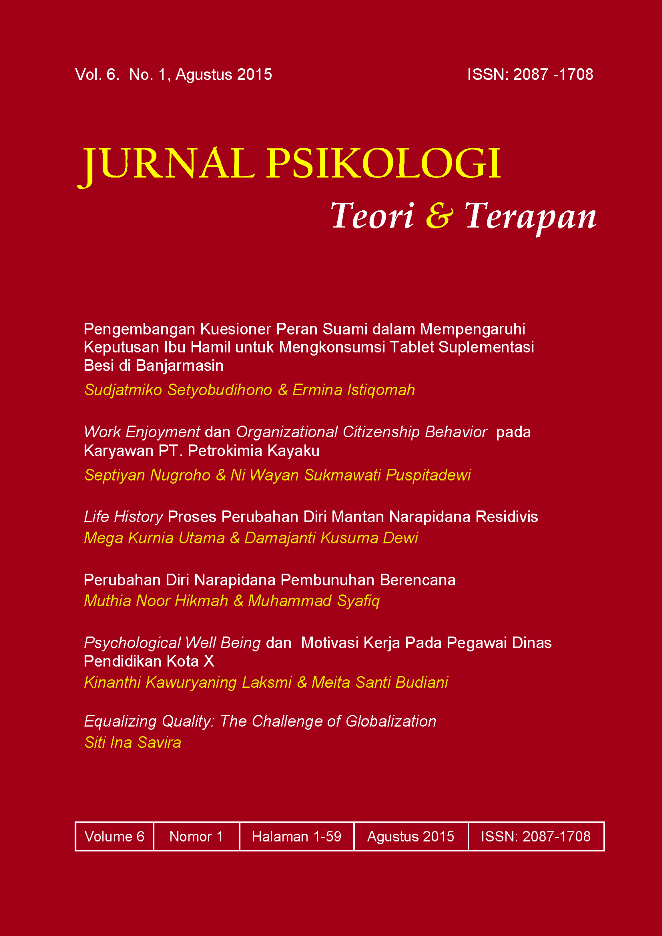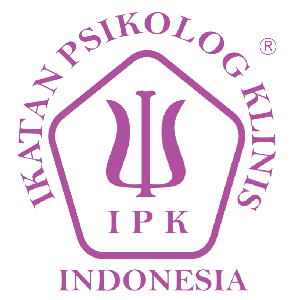Psychological Well Being dan Motivasi Kerja Pada Pegawai Dinas Pendidikan
DOI:
https://doi.org/10.26740/jptt.v6n1.p50-53Keywords:
Psychological well being, motivasi kerjaAbstract
The purpose of this research was to examine the relationship between psychological well being and working motivation of employees. The method used in this study was a quantitative correlational design. The subjects of this study were 64 employees of bureau of education level III at œX city, which were selected by using population sampling technique. Data of psychological well-being and working motivation were obtained by using Likert scales. The technique of data analysis in this study was Pearsons product moment. The result of this study shows that the coefficient correlation is 0.788 in the Significant level of 0.000. The result means that the hypothesis is accepted, that there is positive correlation between psychological well-being and working motivation. The result also indicates that 78.8% of working motivation influenced by psychological well-being and the rest of it 21.2% influenced by other variables that were not measured in this study.
Abstrak: Penelitian ini bertujuan untuk mengetahui hubungan psychological well- being dengan motivasi kerja pegawai. Penelitian ini menggunakan metode kuantitatif korelasional. Subjek dalam penelitian ini ialah 64 pegawai golongan III di Dinas Pendidikan Kota X yang dipilih dengan menggunakan teknik sampling populasi. Data dikumpulkan menggunakan skala likert berupa skala psycgological well-being dan skala motivasi kerja. Teknik analisis data dalam penelitian ini adalah uji analisis korelasi. Hasil penelitian menunjukan bahwa psychological well-being memiliki hubungan yang signifikan dengan motivasi kerja dengan arah hubungan yang positif, dapat dilihat dari signifikansi sebesar 0,000 dan yang artinya sebesar 78,8% pada motivasi kerja dipengaruhi oleh psychological well-being dan sisanya sebesar 21,2% dipengaruhi oleh variabel lain yang tidak diukur dalam penelitian ini.
References
Arikunto, S. (2005). Manajemen Penelitian. Jakarta: Rineka Cipta.
Asnawi, S. (2007). Teori Motivasi. Jakarta: Studia Press.
Azwar, S. (2009). Reliabilitas dan Validitas. Yogyakarta: Pustaka Pelajar.
Azwar, S. (2011). Penyusunan Skala Psikologi. Yogyakarta: Pustaka Pelajar.
Munandar, Ashar Sunyato. (2008). Psikologi Industri dan Organisasi. Jakarta: Universitas Indonesia Press.
Narbuko, C., Achmadi, A, H. (2004). Metodologi Penelitian. Jakarta: PT. Bumi Aksara.
Robbins, Stephen P. (2006). Perilaku Organisasi (alih bahasa Benjamin Molan). Edisi Bahasa Indonesia. Klaten: PT. Int An Sejati.
Ryff, C. D. & Keyes, C. L. M. (1995). The Structure of Psychological Well Being. Journal of Personality and Social Psychology, 69 (4) 719-727.
Siagian, S. (2002). Teori Motivasi dan Aplikasinya. Jakarta: PT. Rineka Cipta.
Sugiyono. (2009). Metode Penelitian Kuantitatif, Kualitatif, dan R&D. Bandung: Alfabeta.
Sugiyono. (2007). Statistika Untuk Penelitian. Bandung: Alfabeta.
Suryabrata, S. (2005). Metodologi Penelitian. Jakarta: PT. Raja Grafindo Persada.
Wibowo, Agung Edy.(2012). Aplikasi Praktis SPSS Dalam Penelitian. Yogyakarta: Gava Media.
Winardi, J. (2002). Motivasi dan Pemotivasian dalam Manajemen. Jakarta: Grafindo Persada.
Downloads
Published
How to Cite
Issue
Section
License
Authors who publish in this journal agree to the following terms:
Copyright in any article is held by the author.
The author grants the journal, publication rights with the work simultaneously licensed under a Creative Commons Attribution License that allows others to share the work with an acknowledgment of the work's authorship and initial publication in this journal.
Authors may enter into separate, additional contractual arrangements for the non-exclusive distribution of the journal's published version of the work (e.g., posting it to an institutional repository or publishing it in a book), with an acknowledgment of its initial publication in this journal.
Authors are permitted and encouraged to post their work online (e.g., in an institutional repository or on their website) prior to and during the submission process, as this can lead to productive exchanges, as well as earlier and greater citation of published work.
 Abstract views: 4154
,
Abstract views: 4154
, PDF Downloads: 2005
PDF Downloads: 2005


















